"Well Art, what do you have to back up your 'No'?"
------------------
1. I am a retired Bell System employee with 30+ years service. My jobs ranged from installer, repairman, switchman, lineman, splicer, circuit designer, engineer, security / safety supervisor and instructor.
2. I am also a student of the history of the Bell System and its policies, products and procedures.
3. Bell Labs is/was only the research arm of AT&T and it did not produce, or sell, any items.
4. Western Electric was the manufacturing and supply arm of the Bell System, and with very few exceptions, only sold to the parent company's (AT&T) regional Bell operating companies, or RBOC's. (What would become the so-called Baby Bells.)
5. Western Electric sold communications equipment to the War Dept and its successor, the DoD. These items were exact duplicates of the products sold to the RBOC's, but instead of being stamped/branded "Bell System" they were simply branded Western Electric, and the part numbers and complete products had a "W" added to them to distinguish them as War Department items.
6. Western Electric was prohibited by several court cases (called, euphemistically, "Consent Decrees") from selling to private industry. As an example, Western Electric Sound equipment for the movies was one such line of products that was spun off early in the history of the Western company. One major exception, which may be of some interest to us model railroaders, was the railway selector system, using the various 60-type line telephones, bells, selectors and transmitters.
See, for example, this instruction book. It's quite a large file, so open it with discretion if you have a slow connection.
http://doc.telephonecollectors...hing_Tel_Sys_OCR.pdf
7. I am familiar with all the types of relays that were produced by WE. If any specialized relays were used by the RBOC's or used in out-sourced assemblies, that were not made in-house (as 98% of the millions of parts were) they would have been marked with the "KS-xxxx" nomenclature. The KS stood for Kearny (NJ) Supply. The giant Kearny Works, covering hundreds of acres, was the national central manufacturing and supply source for all Bell System products. Specialized or short order items were sourced from outside the System only when absolutely necessary, and always were coded with the KS- prefix. The System was compulsive about marking every last item with its number and revision letter(s). Some very small runs of specialized equipment (generally hand tools) were sourced from outside the System and carried the "AT-xxxx" series of nomenclature. The AT was shorthand for AT&T.
8. No central office, subscriber, carrier, military, or specialized product of which I can think ever used a relay that selectively responded to AC and DC, in the exact way that the Lionel whistle relay does.
9. In all my years of immersion into the history of telephony and into the hobby of train collecting, with a special interest in controls and signalling, I would have no doubt heard this story before, and it would have been the source of debate among my peers and colleagues. I have not heard it before today.
10. I have read, or at least perused, during the last 50 years of my life, every available Western Electric catalog starting with the extremely rare Catalog #1. I have never seen a reference to a relay of the type under discussion.
11. The relay, in concept, is not an especially clever design. It could not have been, nor can it now, be patented.
12. Lionel made most of its products in-house. The Bell System made most of its products in its house. In the event that Lionel did out-source the whistle relay, it would be surprising and inconsistent with what we have all been taught about Mr. Cowen's business model and personality, since Lionel prided itself, as did most industrial giants of the era, in being vertically integrated, just like the Bell System. It would have been ludicrous for Ma Bell to supply anything to Lionel.
13. Concurrent with my career as a phone man, I have been a train operator, collector, and student of the electrical side of toy trains since 1954. I have designed and implemented circuitry for myself and some close friends. I have never considered that the whistle relay might have been out-sourced, and definitely never considered the far-fetched idea that they came from the Bell System.
14. Knowing, at least apocryphally, the man, the ego, and the personality of JLC, I would imagine that if the words Bell Labs, whistle relay and Lionel were ever to have been uttered in the same sentence, old Mr. Cowen would have spun it the other way 'round.
I am confident in my assertions. However, I am not dogmatic or stubborn. If anyone can supply a WE, AT- or KS- reference for the Lionel relay, I would be delighted to read it, and I will cordially admit my mistake.




![CropperCapture[129] CropperCapture[129]](https://ogrforum.ogaugerr.com/fileSendAction/fcType/0/fcOid/41835032915232557/filePointer/41835032951843034/fodoid/41835032951843027/imageType/MEDIUM/inlineImage/true/CropperCapture%255B129%255D.jpg)
![CropperCapture[129] CropperCapture[129]](https://ogrforum.ogaugerr.com/fileSendAction/fcType/0/fcOid/41835032915232557/filePointer/41835032951843034/fodoid/41835032951843027/imageType/SQUARE_THUMBNAIL/inlineImage/true/CropperCapture%5B129%5D.jpg)



